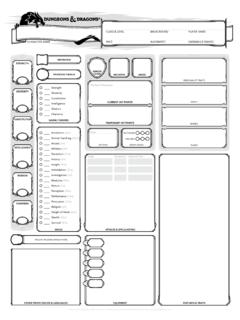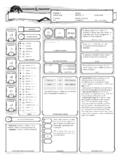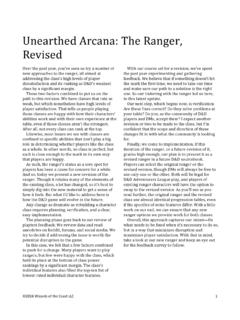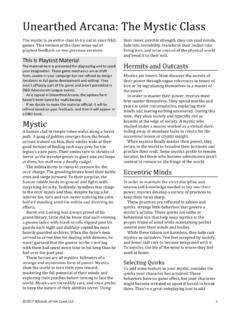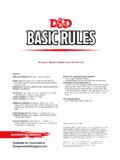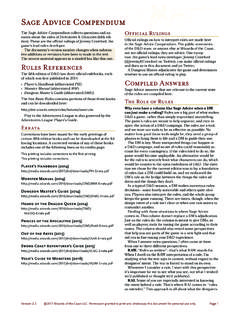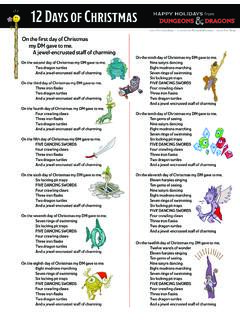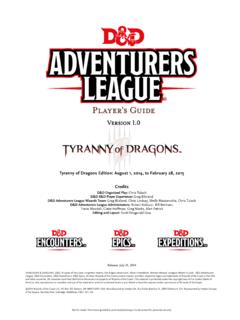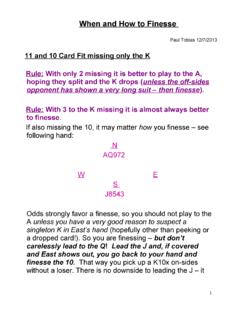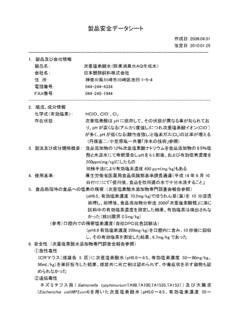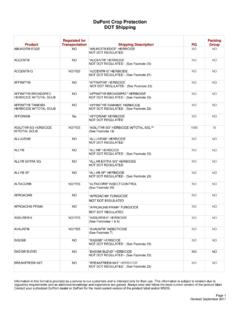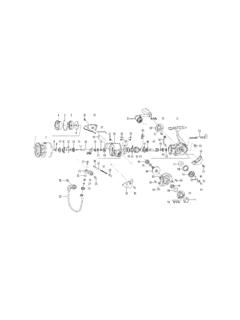Transcription of Sage Advice Compendium - Wizards Corporate
1 Version @2015 Wizards of the Coast LLC. Permission granted to print and photocopy this document for personal use only. Page 1 sage Advice CompendiumQuestions and answers about the rules of fifth edition Dungeons & Dragons appear in sage Advice , a monthly column on the D&D website ( ). This document compiles most of them and organizes them by topic, after first noting what the game s official rules ref-erences are. If you have a question that you d like addressed in sage Advice , please email it to ReferencesThe fifth edition of D&D has three official rulebooks, each of which was first published in 2014: Player s Handbook (abbreviated PH) Monster Manual (abbreviated MM) Dungeon Master s Guide (abbreviated DMG)The free Basic Rules contains portions of those three books and can be downloaded here.
2 In the Adventurers League, the D&D organized play program, is also governed by the Adventurers League Play-er s June of 2015, a modest number of corrections were issued for the first two printings of the Player s Handbook and can be downloaded here: corrections have been incorporated into more recent printings of the book, as well as into the Basic Rules. A corrected version of the book includes the following text toward the bottom of its credits page:This printing includes corrections to the first RulingsOfficial rulings on how to interpret unclear rules are made in sage Advice . The public statements of the D&D team, or anyone else at Wizards of the Coast, are not official rulings; they are Advice .
3 One exception: the game s rules manager, Jeremy Crawford (@JeremyECrawford), can make official rulings and usually does so in sage AnswersSage Advice answers that are relevant to the current state of the rules are compiled here. In other words, an answer that has become obsolete isn t included in this Role of Rules Why even have a column like sage Advice when a DM can just make a ruling? Rules are a big part of what makes D&D a game, rather than simply improvised storytelling. The game s rules are meant to help organize, and even in-spire, the action of a D&D campaign. The rules are a tool, and we want our tools to be as effective as possible.
4 No matter how good those tools might be, they need a group of players to bring them to life and a DM to guide their use. The DM is key. Many unexpected things can happen in a D&D campaign, and no set of rules could reasonably ac-count for every contingency. If the rules tried to do so, the game would become unplayable. An alternative would be for the rules to severely limit what characters can do, which would be counter to the open-endedness of D&D. The direc-tion we chose for the current edition was to lay a foundation of rules that a DM could build on, and we embraced the DM s role as the bridge between the things the rules ad-dress and the things they don t.
5 In a typical D&D session, a DM makes numerous rules decisions some barely noticeable and others quite obvi-ous. Players also interpret the rules, and the whole group keeps the game running. There are times, though, when the design intent of a rule isn t clear or when one rule seems to contradict another. Dealing with those situations is where sage Advice comes in. This column doesn t replace a DM s adjudication. Just as the rules do, the column is meant to give DMs, as well as players, tools for tuning the game according to their tastes. The column should also reveal some perspectives that help you see parts of the game in a new light and that aid you in fine-tuning your D&D experience.
6 When I answer rules questions, I often come at them from one to three different perspectives. R AW. Rules as written that s what RAW stands for. When I dwell on the RAW interpretation of a rule, I m studying what the text says in context, without regard to the designers intent. The text is forced to stand on its own. Whenever I consider a rule, I start with this perspective; it s important for me to see what you see, not what I wished we d published or thought we published. RAI. Some of you are especially interested in knowing the intent behind a rule. That s where RAI comes in: rules as intended.
7 This approach is all about what the designers meant when they wrote something. In a perfect world, RAW and RAI align perfectly, but sometimes the words on the page don t succeed at communicating the designers intent. Or perhaps the words succeed with one group of players but fail with another. When I write about the RAI interpretation of a rule, I ll be pulling back the curtain and letting you know what the D&D team meant when we wrote a certain rule. R A F. Regardless of what s on the page or what the de-signers intended, D&D is meant to be fun, and the DM is the ringmaster at each game table.
8 The best DMs shape the game on the fly to bring the most delight to his or her play-ers. Such DMs aim for RAF, rules as fun. We expect DMs to depart from the rules when running a particular campaign or when seeking the greatest hap-piness for a certain group of players. Sometimes my rules answers will include Advice on achieving the RAF interpre-tation of a rule for your group. I recommend a healthy mix of RAW, RAI, and RAF! Will there be errata for the core books? Yes. We ve been studying Twitter, forums, emails, and our play experiences to find out where the core books need correction.
9 We ve started with corrections for the Player s Handbook and will then move on to the other @2015 Wizards of the Coast LLC. Permission granted to print and photocopy this document for personal use only. Page 2 Does the Archery fighting style work with a melee weapon that you throw? No, the Archery feature benefits ranged weapons. A melee weapon, such as a dagger or handaxe, is still a melee weapon when you make a ranged attack with it. Is the Dueling fighting style intended to support a shield? Yes. A character with the Dueling option usually pairs a one-handed weapon with a shield, a spellcasting focus, or a free hand.
10 If a monk uses a staff or another versatile weapon two-handed, does it still count as a monk weapon? Ye s . A monk weapon must lack the two-handed property, but nothing prevents a monk from wielding such a weapon with two hands. Fundamentally, a monk weapon counts as such no matter how a monk uses it. Does the Martial Arts feature turn monk weapons and unarmed strikes into finesse weapons? Nope. The feature grants a benefit that is similar to the finesse property, but the feature doesn t confer that property. It would say so if it did. Does a monk s Purity of Body feature grant immunity to poison damage, the poisoned condition, or both?
